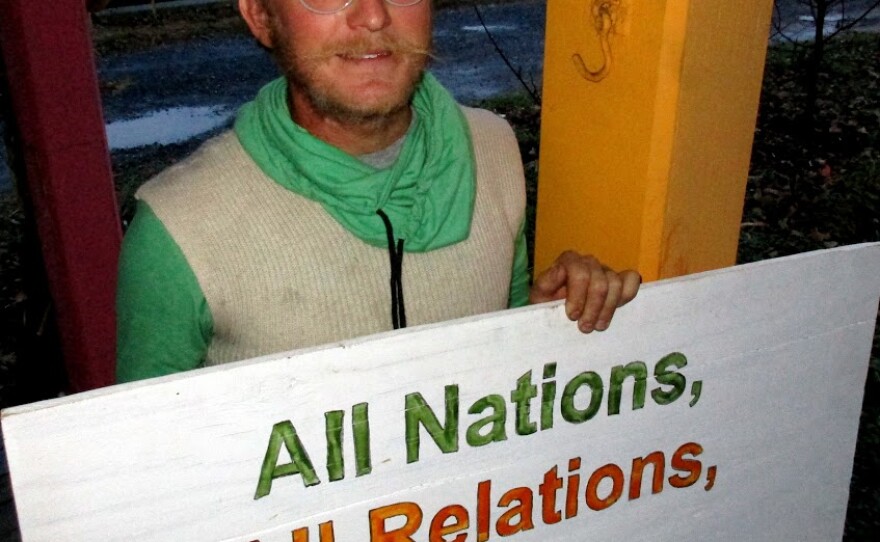The recent and ongoing Dakota Access Pipeline protests at the Standing Rock reservation have drawn activists from around the country, including from Harrisonburg. WMRA’s Christopher Clymer Kurtz filed this report about one local protester’s experience there.
As Cornelius Frantz neared Sacred Stone Camp at Standing Rock last month with his carload of food, warm blankets, and two winter-insulated army tents for the protestors, he saw two signs:
CORNELIUS FRANTZ: This giant sign that says, “We are unarmed,” and that to me is one of the most beautiful things. This is a camp of people who are committed to nonviolent direct action and just to witness, and to peace. The next sign I saw was, "No drugs or alcohol. This is a camp for prayer."
Frantz spent eight days in mid-November at Sacred Stone Camp as an emissary of Renew Rocktown, a young collective that has worked to activate Harrisonburg around the Standing Rock movement, in part by erecting a teepee with signs and information around town. At Standing Rock, he says, he -- of non-native, white settler folk -- was embraced as family in this movement that he learned was not only about the Dakota Access Pipeline.
FRANTZ: It was to connect people to each other and to find healing. The first evening I was there an elder expressed that we're not here for just this pipeline to stop, but we're here to stop the school-to-prison pipeline for low-income, minority youth. We're here to target the pipeline of moving people out that are labeled illegal in this country and forcibly removing them from the States. And so that was really powerful to see the witness of the commitments being drawn to a much larger thing, for healing, not just for ecological protection but for the changing of hearts and for putting compassion in people's hearts
Two particular protests from his trip are most vivid in his memory. The first was a sunlit vigil on a bridge, a peaceful prayer led by native women wearing bright red colors in honor of Red Fawn, an imprisoned protestor. The other, for him, represented the fortitude of the protesters.
FRANTZ: Two days later on that same bridge, another peaceful protest, just for prayer, just quiet prayer, meditation, and song, we were hit with the water cannons pretty immediately. What sticks vividly in my mind, there was just many native people and many people who are accomplices dancing in the water hoses because it was early in the evening. There was dancing, there was, you know, an atmosphere of mni wiconi, water is life, they're using water against us, they're pouring it right into us.
https://www.youtube.com/watch?v=t8MXMpaQUx0
Temperatures that night dropped below freezing, and Frantz says many protesters ended up in the hospital with hypothermia. Others suffered direct sprays of mace. Frantz’s job was to use a basic solution to clean people’s eyes.
FRANTZ: Chemical warfare just delivers fear and pain, and so to try to orient people, to help them to feel calm, was a really big privilege. Further along in the evening we were able to build fires to warm up, people could try to put on fresh clothes, everyone was bringing up food from the camps, we were offering food to the National Guard, telling them to walk over to our side, that we had snacks, we had warm fires, come be by us, just that attitude of openness to the other, even though the other was a militarized force with a huge blockade and shields and pretty scary, three different water cannons coming up and down the line, just spraying us. And we were just trying to keep the fires lit to stay warm, just to stay there, and kind of hold our vigil.
Along with protesting, Frantz built winterized structures -- and spent a lot of time in prayer.
FRANTZ: I learned a lot through that process of being introspective, on focusing on healing in our own lives and our own baggage that we carry, and then approaching the front lines and having direct action where we are just giving witness to the demands for justice and doing so with pure thoughts and pure hearts in a way that really calls attention to the evil in this world.
But even as headlines have declared victory for the Standing Rock protestors, and even as Frantz himself is dancing and celebrating, he feels a certain pessimism.
NPR reported this week that Energy Transfer Partners plans “to complete construction of the pipeline without any additional rerouting,” and that president-elect Trump “has expressed support for the pipeline.”





